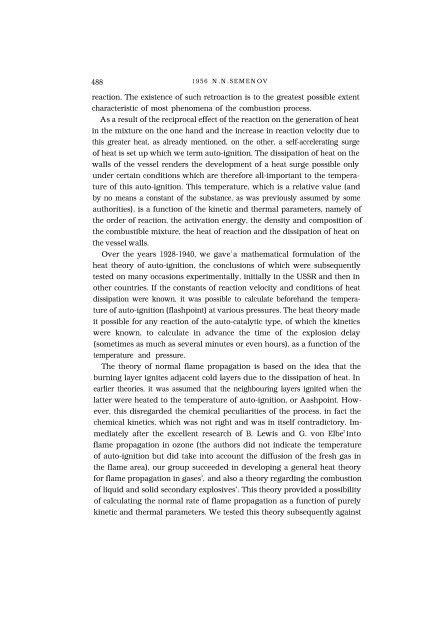Nikolai N. Semenov - Nobel Lecture - Nobelprize.org
Nikolai N. Semenov - Nobel Lecture - Nobelprize.org
Nikolai N. Semenov - Nobel Lecture - Nobelprize.org
You also want an ePaper? Increase the reach of your titles
YUMPU automatically turns print PDFs into web optimized ePapers that Google loves.
488 1956 N.N.SEMENOV<br />
reaction. The existence of such retroaction is to the greatest possible extent<br />
characteristic of most phenomena of the combustion process.<br />
As a result of the reciprocal effect of the reaction on the generation of heat<br />
in the mixture on the one hand and the increase in reaction velocity due to<br />
this greater heat, as already mentioned, on the other, a self-accelerating surge<br />
of heat is set up which we term auto-ignition. The dissipation of heat on the<br />
walls of the vessel renders the development of a heat surge possible only<br />
under certain conditions which are therefore all-important to the temperature<br />
of this auto-ignition. This temperature, which is a relative value (and<br />
by no means a constant of the substance, as was previously assumed by some<br />
authorities), is a function of the kinetic and thermal parameters, namely of<br />
the order of reaction, the activation energy, the density and composition of<br />
the combustible mixture, the heat of reaction and the dissipation of heat on<br />
the vessel walls.<br />
Over the years 1928-1940, we gave 1 a mathematical formulation of the<br />
heat theory of auto-ignition, the conclusions of which were subsequently<br />
tested on many occasions experimentally, initially in the USSR and then in<br />
other countries. If the constants of reaction velocity and conditions of heat<br />
dissipation were known, it was possible to calculate beforehand the temperature<br />
of auto-ignition (flashpoint) at various pressures. The heat theory made<br />
it possible for any reaction of the auto-catalytic type, of which the kinetics<br />
were known, to calculate in advance the time of the explosion delay<br />
(sometimes as much as several minutes or even hours), as a function of the<br />
temperature and pressure.<br />
The theory of normal flame propagation is based on the idea that the<br />
burning layer ignites adjacent cold layers due to the dissipation of heat. In<br />
earlier theories, it was assumed that the neighbouring layers ignited when the<br />
latter were heated to the temperature of auto-ignition, or Aashpoint. However,<br />
this disregarded the chemical peculiarities of the process, in fact the<br />
chemical kinetics, which was not right and was in itself contradictory. Immediately<br />
after the excellent research of B. Lewis and G. von Elbe 2 into<br />
flame propagation in ozone (the authors did not indicate the temperature<br />
of auto-ignition but did take into account the diffusion of the fresh gas in<br />
the flame area), our group succeeded in developing a general heat theory<br />
for flame propagation in gases 3 , and also a theory regarding the combustion<br />
of liquid and solid secondary explosives’. This theory provided a possibility<br />
of calculating the normal rate of flame propagation as a function of purely<br />
kinetic and thermal parameters. We tested this theory subsequently against
















